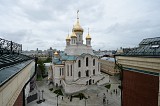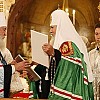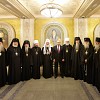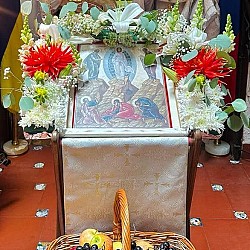“Your Holiness, Your Eminences, dear friends!
“The ceremony of the consecration of the new church of Sretensky Monastery is an important and meaningful event not only for the Orthodox faithful, but for our society as a whole.
“And this is why: This church is dedicated to the Resurrection of Christ and to the New Martyrs, that is, to the memory of those who suffered for their faith during the period of militant atheism, who died in the purges; and along with that, it personifies reconciliation.
“It is deeply symbolic that this new church is opening in the centennial year of the February and October revolutions, which became the point of departure for very many of the most severe trials which our country passed through in the twentieth century.
“We must remember both the bright and the tragic pages of history, to learn to perceive it as a whole, objectively, suppressing nothing. Only thus is it fully possible to understand and comprehend the lessons that the past presents to us.
“We know how fragile civil peace is—we know it now—and we must never forget it. We must not forget how hard it is to heal the wounds of schisms.
“Therefore it is our common duty to do all that we can to preserve the unity of the Russian nation, to support socio-political harmony through ongoing dialogue, and, leaning on our traditional values, on the values of our traditional religions—Orthodoxy, Islam, Judaism, Buddhism—to not allow any bitterness, or any divisions.
The sense of a common purpose, chief of which is the wellbeing of every person and of our Fatherland as a whole, is the key to helping overcome divisions. The clearest confirmation of this is the restoration of the unity of the Russian Orthodox Church, the tenth anniversary of which we are celebrating these days.[1]
“The path to restoring the Church’s wholeness, to the unification of the Russian Orthodox Church of the Moscow Patriarchate and the Russian Orthodox Church Abroad was not easy, and it could not have been otherwise: Too many conflicts and mutual distrust had accumulated during the long years of disunity, rooted in the drama of the fratricidal civil war.
“The Russian Orthodox Church here, in Russia, suffering, sustaining great losses, was always there with its people. And the Russian Orthodox Church Outside of Russia always helped our compatriots finding themselves far from the Fatherland, not only to preserve the faith, but to feel their close connection with the Fatherland, with Russia, with its traditions, and language, and with our culture.
“The restoration of unity has strengthened this link. It was and remains an event of great moral sounding, and a symbol and example that the history of our country and its past should not divide, but unite us all.
“Our country, and Russian statehood itself is impossible to imagine without the spiritual and historical experience of the Russian Orthodox Church, which is passed down from generation to generation through pastoral words. I am certain that Sretensky Monastery’s new church will become a bright and magnetic center of religious and enlightenment activity, and will facilitate the inculcation in our society of the idea of goodness, mutual respect, and peacemaking.
“Congratulations!”
The head of state then presented a nineteenth-century icon of St. John the Forerunner as a gift to the Church of the Resurrection of Christ and the New Martyrs and Confessors of the Russian Church.
In response, His Holiness Patriarch Kirill said, “I would also like to heartily congratulate us all with the tenth anniversary of the reunification of the Russian Church Abroad and the Moscow Patriarchate in the hope that the results of this union will become yet more apparent and significant for our whole Church. We have the time to deepen this unity, to make it even more durable, that it might fully serve for the restoration of piety and faith in our people. Again I greet you all with the feast!”
The faithful were given an icon of Hieromartyr Hilarion with the blessing of the patriarch.
Then the president and the primate of the Russian Church visited the lower church of the new cathedral, dedicated to St. John the Baptist and the Twelve Apostles.
Then President Putin and His Holiness Patriarch Kirill visited the Sretensky Seminary building, where there was a brief talk between the head of state and the hierarchs of the Russian Church Abroad who had arrived for the consecration of the church.
***
Sretensky Monastery
Sretensky Stavropegial Men’s Monastery was founded in 1397 on the spot of the meeting of the miraculous Vladimir Icon of the Mother of God, in memory of Moscow’s deliverance from Tamerlane’s invasion. The main church was rebuilt in 1677 and consecrated in honor of the Meeting of the Vladimir Icon of the Mother of God.
Sretensky Monastery played an active role in the election of Michael Fedorovich as Tsar—the first tsar of the Romanov Dynasty. Practically every pilgrimage of the tsars, patriarchs, metropolitans, and princes always began with prayers in Sretensky Monastery.
The monastery was closed in 1926, then becoming the site of a dormitory for officers of the NKVD.[2] Until the 1990s, the Grabar All-Union Art Restoration Center was located in the Sretensky cathedral.
In 1991, the cathedral building was transferred for use to the Russian Orthodox Church and a podvoriye of the Pskov Caves Monastery was opened. In 1996, the podvoriye was transformed into the Sretensky Stavropegial Men’s Monastery, with Bp. Tikhon (Shevkunov) of Egorievsk (then Igumen) being appointed as abbot.
In 1999, classes of the Sretensky Monastery Orthodox School began, which became a seminary in 2001. One of the largest publishing houses of the Russian Orthodox Church is located in the monastery. The internet site Pravoslavie.ru was created in Sretensky Monastery in 2000.
***
The Church of the Resurrection of Christ and the New Martyrs and Confessors of the Russian Church
The decision to build the church was made at the March 3, 2011 meeting of the Board of Trustees. In December 2012, an open competition was held for designing the new church. Among the design requirements was “a representation of an idea for the house of God traditional to Russian Church architecture, and also of the spiritual feats and celebration of the spiritual victory of the New Martyrs.”
A thorough archaeological excavation took place before the beginning of construction. The building of the cathedral and the reconstruction of the monastery territory began in 2014 and took 866 working days.
The church is 200 feet high. The most modern technology was implemented in its construction. It is equipped with a ventilation and air-conditioning system for maintaining the internal climate. Lighting, heating, audio and video are controlled by digital equipment.
The cathedral is lined with stone carvings of white Vladimir limestone. The ancient white cathedrals of Vladimir, Suzdal, and Moscow were constructed from such stone. 29,000 pieces with a total volume of 32,100 cubic feet were made to realize the stone carving. The church is decorated with carvings not only outside, but also inside. 4,500 pieces of stone with a volume of 8,100 cubic feet were used for the internal carvings.
The church complex has several floors. The upper church is in honor of the Resurrection of Christ and the New Martyrs and Confessors of the Russian Church.
It is not by chance that the lower church of the new cathedral is dedicated to St. John the Forerunner and the Twelve Apostles. In the center is a baptistery, decorated with unique mosaics according to the style of ancient Byzantine churches. Courses on the basics of the Orthodox faith will be held around the baptistery for those preparing for Baptism. The two bottom floors will have an auditorium for educational and youth activities. Two museums will be created in the church: on the New Martyrs, and on the Shroud of Turin.
The total area of frescoes in the cathedral is 70,300 square feet. Forty-seven icons were painted especially for the church, the majority of which are in the Russian-Byzantine traditions. The mosaic icons and mosaic baptistery were made from smalt in the rare style of Lomonosov mosaics.
The square in front of the cathedral is built as a church under the open sky. The patriarchal veranda can serve as an altar. This provides the opportunity for 5,000 people to participate and clearly hear the famous Sretensky Choir sing the Divine services during the warm times of year.
The new church’s seven golden domes, decorated with an arcature belt, are clearly visible from various points throughout Moscow. According to famous Moscow artists and architects, the new Church of the Resurrection of Christ and the New Martyrs and Confessors of the Russian Church has become one of the dominant features of the old section of the capital, continuing the ancient traditions connecting our Fatherland’s past and present.









